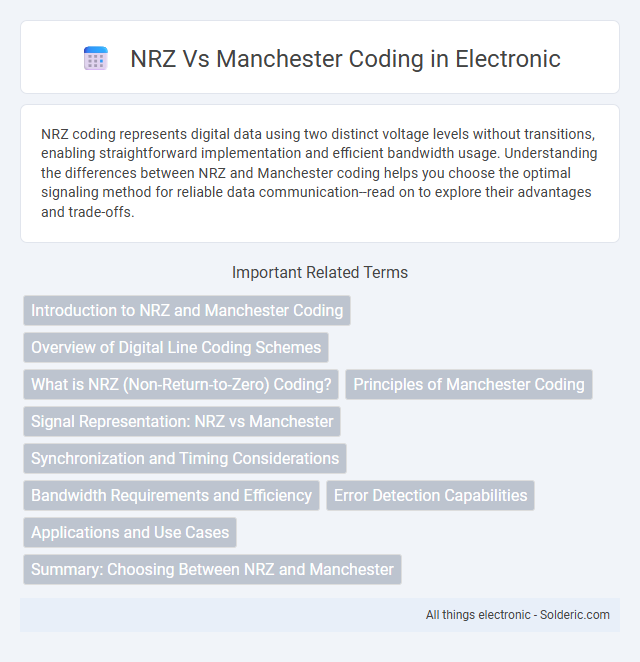NRZ coding represents digital data using two distinct voltage levels without transitions, enabling straightforward implementation and efficient bandwidth usage. Understanding the differences between NRZ and Manchester coding helps you choose the optimal signaling method for reliable data communication--read on to explore their advantages and trade-offs.
Comparison Table
| Feature | NRZ (Non-Return to Zero) | Manchester Coding |
|---|---|---|
| Signal Representation | Binary '1' and '0' represented by two distinct voltage levels without return to zero. | Each bit contains a transition; '0' and '1' represented by voltage change at mid-bit. |
| Bandwidth Efficiency | Higher bandwidth efficiency as it uses one level per bit. | Lower bandwidth efficiency, requires twice the bandwidth due to transitions per bit. |
| Synchronization | Poor synchronization, prone to long runs of same bits causing clock drift. | Excellent synchronization due to guaranteed mid-bit transitions. |
| Error Detection | Limited error detection capability. | Improved error detection from regular voltage transitions. |
| Complexity | Simple to implement with minimal hardware. | More complex encoding and decoding circuitry required. |
| Applications | Used in simpler, low-speed digital communication. | Common in Ethernet and RFID for better synchronization. |
Introduction to NRZ and Manchester Coding
NRZ (Non-Return-to-Zero) coding represents binary data with distinct voltage levels, where a high voltage indicates a binary 1 and a low voltage indicates a binary 0, enabling straightforward signal interpretation but susceptible to synchronization issues. Manchester coding combines clock and data signals by encoding each bit with a voltage transition at the midpoint, ensuring easier synchronization and error detection through frequent transitions. Both encoding schemes are fundamental in digital communication systems, with NRZ favored for simplicity and Manchester chosen for improved timing accuracy.
Overview of Digital Line Coding Schemes
NRZ (Non-Return-to-Zero) coding represents digital data using two distinct voltage levels without returning to zero between bits, offering simplicity and higher data rates but suffering from synchronization issues due to lack of signal transitions. Manchester coding combines clock and data signals by encoding each bit as a transition, enhancing synchronization and error detection at the expense of doubling the required bandwidth compared to NRZ. Both line coding schemes convert binary data into suitable electrical signals for transmission, balancing trade-offs between bandwidth efficiency, synchronization capabilities, and implementation complexity.
What is NRZ (Non-Return-to-Zero) Coding?
NRZ (Non-Return-to-Zero) coding is a binary signal encoding method where the signal amplitude remains constant during the bit interval, representing binary '1' and '0' without returning to zero voltage between bits. This technique increases data transmission efficiency by minimizing signal transitions and bandwidth usage, making it ideal for high-speed communication systems. Your choice of NRZ coding can enhance data integrity in environments where synchronization and low bandwidth consumption are crucial.
Principles of Manchester Coding
Manchester coding encodes data by representing logical '0' and '1' through voltage transitions within each bit period, ensuring a mid-bit transition for synchronization. This method improves clock recovery by embedding timing information directly into the signal, making it immune to baseline wander and facilitating error detection. Unlike NRZ coding, Manchester coding guarantees frequent signal changes, which enhances signal integrity over long-distance communication.
Signal Representation: NRZ vs Manchester
NRZ (Non-Return-to-Zero) coding represents binary data with two distinct voltage levels, where a high voltage typically indicates a binary 1 and a low voltage a binary 0, maintaining a constant signal level throughout the bit duration. Manchester coding combines clock and data into a single self-synchronizing signal, using a voltage transition at the midpoint of each bit period to indicate both data bits and timing. While NRZ offers simpler implementation and higher bandwidth efficiency, Manchester encoding provides improved synchronization and error detection due to its guaranteed signal transitions.
Synchronization and Timing Considerations
NRZ coding lacks inherent synchronization features, making it prone to signal ambiguity during long sequences of identical bits, which complicates clock recovery and timing synchronization. Manchester coding embeds clock information within the signal by encoding each bit with a transition, ensuring reliable timing recovery and synchronization even in noisy environments. This built-in synchronization advantage makes Manchester coding preferable for systems requiring precise timing, such as Ethernet and other high-speed communication protocols.
Bandwidth Requirements and Efficiency
NRZ coding requires lower bandwidth as it uses two voltage levels to represent binary data, making it more efficient for long-distance transmissions. Manchester coding doubles the bandwidth requirement since it encodes each bit with a transition, improving synchronization but reducing spectral efficiency. Consequently, NRZ offers higher data throughput within limited bandwidth, whereas Manchester provides better timing recovery at the cost of increased bandwidth usage.
Error Detection Capabilities
Manchester coding incorporates inherent error detection by encoding data with a transition in the middle of each bit period, enabling the receiver to identify timing errors and signal integrity issues effectively. NRZ (Non-Return-to-Zero) coding lacks built-in error detection, as it represents binary data with two distinct voltage levels without guaranteed transitions, making it more susceptible to synchronization errors and undetected data corruption. Therefore, Manchester coding enhances communication reliability through its self-clocking and error-detecting properties compared to NRZ coding.
Applications and Use Cases
NRZ coding is widely used in low-complexity communication systems such as USB and serial data transmissions where bandwidth efficiency is critical. Manchester coding excels in Ethernet and RFID applications due to its robust synchronization capabilities and error detection features. Your choice between NRZ and Manchester depends on balancing bandwidth efficiency against synchronization reliability in the target communication environment.
Summary: Choosing Between NRZ and Manchester
NRZ (Non-Return-to-Zero) coding offers simplicity and higher bandwidth efficiency, making it suitable for longer-distance communication with lower complexity. Manchester coding ensures better synchronization and error detection by embedding clock signals within the data, which makes it ideal for digital communication systems requiring reliability. Your choice between NRZ and Manchester depends on the need for either efficient data transmission or robust synchronization and error resilience.
NRZ vs Manchester Coding Infographic

 solderic.com
solderic.com